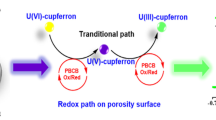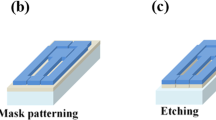Abstract
The authors describe a microsensor for the determination of biochemical oxygen demand. Different from established BOD detection schemes that incorporate a film of immobilized microbes, the sensitive element of this BOD microsensor consists of magnetite-functionalized Bacillus subtilis that can be immobilized and regenerated on an ultramicroelectrode array (UMEA). Modification and regeneration are magnetically controlled. The oxygen consumed is amperometrically quantified by using an UMEA modified with palladium nanoparticles and reduced carboxy graphene. The assay can be performed within 5 min owing to the fast mass transfer of the magnetite-functionalized microbes on the surface of the UMEA. The calibration plot, best acquired at a voltage of -0.4 V vs. Ag/AgCl, is linear in the 2 to 15 mg⋅L−1 BOD concentration range. A critical comparison with other BOD sensor shows the sensitivity of this sensor to be largely improved. It was successful applied to the determination of BOD in spiked water samples.

Schematic presentation of the novel biochemical oxygen demand (BOD) microsensor. The sensitive element can be modified and renewed on ultramicroelectrode array by using a magnet. The response time and the sensitivity of the microsensor are largely improved.




Similar content being viewed by others
References
Yudina NY, Arlyapov VA, Chepurnova MA, Alferov SV, Reshetilov AN (2015) A yeast co-culture-based biosensor for determination of waste water contamination levels. Enzym Microb Technol 78:46–53
Karube I, Matsunaga T, Mitsuda S, Suzuki S (1977) Microbial electrode BOD sensors. Biotechnol Bioeng 19:1535–1547
Cao J, Nagl S, Kothe E, Köhler JM (2015) Oxygen sensor nanoparticles for monitoring bacterial growth and characterization of dose-response functions in microfluidic screenings. Microchim Acta 182:385–394
Chee G, Nomura Y, Ikebukuro K, Karube I (2000) Optical fiber biosensor for the determination of low biochemical oxygen demand. Biosens Bioelectron 15:371–376
Yoshida N, Hoashi J, Morita T, McNiven SJ, Yano K, Yoshida A, Nakamura H, Karube I (2001) Monitoring of the composting process using a mediator-type biochemical oxygen demand sensor. Analyst 126:1751–1755
Yang Z, Suzuki H, Sasaki S, McNiven S, Karube I (1997) Comparison of the dynamic transient- and steady-state measuring methods in a batch type BOD sensing system. Sensors Actuators B 45:217–222
Yang Z, Sasaki S, Karube I, Suzuki H (1997) Fabrication of oxygen electrode arrays and their incorporation into sensors for measuring biochemical oxygen demand. Anal Chim Acta 357:41–49
Yoshida N, Yano K, Morita T, McNiven SJ, Nakamura H, Karube I (2000) A mediator-type biosensor as a new approach to biochemical oxygen demand estimation. Analyst 125:2280–2284
Yoshida N, Hoashi J, Morita T, McNiven SJ, Nakamura H, Karube I (2001) Improvement of a mediator-type biochemical oxygen demand sensor for on-site measurement. J Biotech 88:269–275
Nakamura H, Abe Y, Koizumi R, Suzuki K, Mogi Y, Karube I (2007) A chemiluminescence biochemical oxygen demand measuring method. Anal Chim Acta 602:94–100
Nakamura H, Kobayashi S, Hirata Y, Suzuki K, Mogi Y, Karube I (2007) A spectrophotometric biochemical oxygen demand determination method using 2,6-dichlorophenolindophenol as the redox color indicator and the eukaryote Saccharomyces cerevisiae. Anal Biochem 369:168–174
Morris K, Catterall K, Zhao H, Pasco N, John R (2001) Ferricyanide mediated biochemical oxygen demand development of a rapid biochemical oxygen demand assay. Anal Chim Acta 442:129–139
Catterall K, Morris K, Gladman C, Zhao H, Pasco N, John R (2001) The use of microorganisms with broad range substrate utilisation for the ferricyanide-mediated rapid determination of biochemical oxygen demand. Talanta 55:1187–1194
Catterall K, Zhao H, Pasco N, John R (2003) Development of a rapid ferricyanide-mediated assay for biochemical oxygen demand using a mixed microbial consortium. Anal Chem 75:2584–2590
Jordan MA, Welsh DT, Teasdale PR, Catterall K, John R (2010) A ferricyanide-mediated activated sludge bioassay for fast determination of the biochemical oxygen demand of wastewaters. Water Res 44:5981–5988
Jordan MA, Welsh DT, John R, Catterall K, Teasdale PR (2013) A sensitive ferricyanide-mediated biochemical oxygen demand assay for analysis of wastewater treatment plant influents and treated effluents. Water Res 47:841–849
Jia J, Tang M, Chen X, Qi L, Dong S (2003) Co-immobilized microbial biosensor for BOD estimation based on sol-gel derived composite material. Biosens Bioelectron 18:1023–1029
Liu L, Shang L, Guo S, Li D, Liu C, Qi L, Dong S (2009) Organic-inorganic hybrid material for the cells immobilization: long-term viability mechanism and application in BOD sensors. Biosens Bioelectron 25:523–526
Liu L, Shang L, Liu C, Liu C, Zhang B, Dong S (2010) A new mediator method for BOD measurement under non-deaerated condition. Talanta 81:1170–1175
Liu L, Deng L, Yong D, Dong S (2011) Native biofilm cultured under controllable condition and used in mediated method for BOD measurement. Talanta 84:895–899
Liu L, Zhang S, Xing L, Zhao H, Dong S (2012) A co-immobilized mediator and microorganism mediated method combined pretreatment by TiO2 nanotubes used for BOD measurement. Talanta 93:314–319
Liu L, Zhai J, Zhu C, Gao Y, Wang Y, Han Y, Dong S (2015) One-pot synthesis of 3-dimensional reduced graphene oxide-based hydrogel as support for microbe immobilization and BOD biosensor preparation. Biosens Bioelectron 63:483–489
Liu L, Bai L, Yu D, Zhai J, Dong S (2015) Biochemical oxygen demand measurement by mediator method in flow system. Talanta 138:36–39
Liu C, Zhao H, Zhong L, Liu C, Jia J, Xu X, Liu L, Dong S (2012) A biofilm reactor-based approach for rapid on-line determination of biodegradable organic pollutants. Biosens Bioelectron 34:77–82
Liu C, Zhao H, Gao S, Jia J, Zhao L, Yong D, Dong S (2013) A reagent-free tubular biofilm reactor for on-line determination of biochemical oxygen demand. Biosens Bioelectron 45:213–218
Liu C, Jia J, Dong S (2013) Biofilm reactor based real-time analysis of biochemical oxygen demand. Biosens Bioelectron 42:1–4
Liu C, Dong S (2013) Field application of a biofilm reactor based BOD prototype in Taihu Lake, China. Talanta 109:147–151
Liu J, Olsson G, Mattiasson B (2004) Short-term BOD (BODst) as a parameter for on-line monitoring of biological treatment process part I. A novel design of BOD biosensor for easy renewal of bio-receptor. Biosens Bioelectron 20:562–570
Ivandini TA, Saepudin E, Wardah H, Dewangga N, Einaga Y (2012) Development of a biochemical oxygen demand sensor using gold-modified boron doped diamond electrodes. Anal Chem 84:9825–9832
Garcia-Alonso J, Fakhrullin RF, Paunov VN, Shen Z, Hardege JD, Pamme N, Haswell SJ, Greenway GM (2011) Microscreening toxicity system based on living magnetic yeast and gradient chip. Anal Bioanal Chem 400:1009–1013
García-Alonsoa J, Fakhrullin RF, Paunov VN (2010) Rapid and direct magnetization of GFP-reporter yeast for micro-screening systems. Biosens Bioelectron 25:1816–1819
Safarik I, Rego LFT, Borovska M, Mosiniewicz-Szablewska E, Weyda F, Safarikova M (2007) New magnetically responsive yeast-based biosorbent for the efficient removal of water-soluble dyes. Enzym Microb Technol 40:1551–1556
Fakhrullin RF, García-Alonso J, Paunov VN (2010) A direct technique for preparation of magnetically functionalised living yeast cells. Soft Matter 6:391–397
Wang J, Bian C, Tong J, Sun J, Hong W, Xia S (2014) Reduced carboxylic graphene/palladium nanoparticles composite modified ultramicroelectrode array and its application in biochemical oxygen demand microsensor. Electrochim Acta 145:64–70
Stergiou DV, Diamanti EK, Gournis DS, Prodromidis MI (2010) Comparative study of different types of graphenes as electrocatalysts for ascorbic acid. Electrochem Commun 12:1307–1309
Polsky R, Harper JC, Wheeler DR, Dirk SM, Rawlings JA, Brozik SM (2007) Reagentless electrochemical immunoassay using electrocatalytic nanoparticle-modified antibodies. Chem Commun 26:2741–2743
Hooi KB, Ismail AK, Ahamad R, Shahir S (2015) A redox mediated UME biosensor using immobilized Chromobacterium Violaceum strain R1 for rapid biochemical oxygen demand measurement. Electrochim Acta 176:777–783
Hu J, Gao G, Xia S (2015) Development of a mediator-mype bioelectrochemical sensor based on polypyrrole immobilized ferricyanide and microorganisms for biochemical oxygen demand fast detection. Int J Electrochem Sci 10:9695–9705
Li Y, Sun J, Wang J, Bian C, Tong J, Li Y, Xia S (2016) A single-layer structured microbial sensor for fast detection of biochemical oxygen demand. Biochem Eng J 112:219–225
Acknowledgements
We acknowledge financial support from National Natural Science Foundation of China (No. 61501423), National Basic Research Program of China (973 Program, No. 2015CB352100), and Project funded by China Postdoctoral Science Foundation (No. 2014 M561055).
Author information
Authors and Affiliations
Corresponding authors
Ethics declarations
The author(s) declare that they have no competing interests.
Electronic supplementary material
ESM 1
(DOCX 382 kb)
Rights and permissions
About this article
Cite this article
Wang, J., Li, Y., Bian, C. et al. Ultramicroelectrode array modified with magnetically labeled Bacillus subtilis, palladium nanoparticles and reduced carboxy graphene for amperometric determination of biochemical oxygen demand. Microchim Acta 184, 763–771 (2017). https://doi.org/10.1007/s00604-016-2055-5
Received:
Accepted:
Published:
Issue Date:
DOI: https://doi.org/10.1007/s00604-016-2055-5




